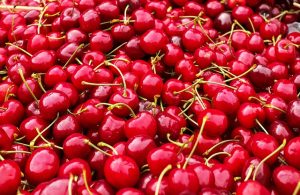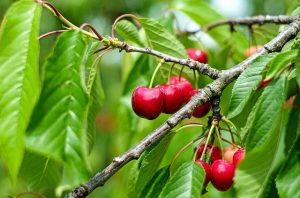
Cherries used to be thought of as very expensive in the shops so it makes perfect sense to grow your own. In the past cherries were renowned for the excessive vigour, making them inappropriate for mall gardens but with the use of modern rootstocks that is no longer an issue.
Cherry trees are a magnificent sight to behold in the spring. Bedecked in white or pink blossoms, it looks as if they have been covered in rosy snow. After that, they produce those delicious cherries we all know and love. Here’s how to grow cherry trees in your own garden!
Cherries are a much loved fruit and are used in dishes such as jams, preserves and pies. The home grown varieties are packed full of flavour. Suitable for growing as an open tree or fan-training. They can be planted in the ground or a large container depending on variety. If your cherries are given the conditions they most desire then they will reward you with flavoursome yields in the summer months.
Conditions For Growing Cherries
Most fruiting trees need a sunny position but cherries actually do better with a slight amount of shade. This mimics their growth in forests. The acid cherries also grow well in north-facing areas. These trees generally require quite specific soil conditions. well-draining earth is ideal as these crops do not prosper in sandy or waterlogged areas. test the pH of your soil using a pH testing kit to check if you have the right compost when container growing. The ideal pH is around 6.5 to 6.7. Add garden lime to raise the pH if too acidic and when too limey, add sulphur chips.

Types of Rootstock
Pruning of cherry trees must be kept to a bare minimum so the choice of rootstock is especially important for this tree. Until recently, the most important rootstock for garden trees was ‘Colt’, a semi-dwarfing stock which produced a tree around 4m tall at maturity. More dwarfing rootstocks are now available such as ‘Gisella 5’, which make growing cherries a more manageable proposition.
These dwarfing rootstocks are used with a great deal of success in warm, sunny sites, but they do not thrive in northerly or exposed gardens. The best way to grow a modest-sized cherry tree is in a pot.
Choose a variety on a ‘Colt’ rootstock where the pot will limit the root system and control growth. use a loam-based compost such as John Innes No3 and keep it evenly watered as the fruit is developing. Yo0u will need to top-dress the pot with fresh compost each Spring, and apply a balanced fertiliser such as Growmore or Vitax Q4.
Planting
- Plant cherries in the late autumn or early spring when the ground is soft and has a higher moisture content.
- For sweet cherries, make sure the different varieties can actually pollinate each other.
- Plant in a sunny site with good air circulation; avoid planting near trees or buildings that shade.
- Cherry trees need deep, well-drained soil.
- Space sweet cherries 35 to 40 feet apart; dwarfs, 5 to 10 feet apart.
- Space tart cherries 20 to 25 feet apart; dwarfs, 8 to 10 feet apart.
- Set trees on standard rootstocks with the graft union a few inches below the soil level. Set trees on dwarf rootstock with the graft union several inches above the soil level.
- When planting fan-trained trees, construct the necessary supports before planting. Plant fans only 12 to 15 feet apart.
- For bareroot trees, place the rootstock on a small mound of soil in the center of the planting hole, and spread the roots down and away, trying not to bend the roots. Backfill with soil.
- For container-grown trees, first remove the rootball and on its side; cut through the roots with shears. Don’t cover the top of the root-ball.

Image by Couleur from Pixabay
Aftercare
•There is no difference in care between sour and sweet cherries.
•Apply mulch to retain moisture.
•Drape netting over trees to protect the fruit from birds.
•Water routinely in dry areas.
•Thinning the fruit is not necessary for cherry trees, as they typically thin naturally in early summer.
•Prune trees every year in late winter to encourage the growth of new fruiting wood. Don’t prune in the fall.
•Fertilize each spring until trees start to bear, then fertilize only after harvest each season.
Harvesting
If you get excited about picking fruit, then taking cherries is one of the best feelings. be careful not to hold the cherry itself as it is so soft. Simply take the stalk with fruit attached. the variety of cherry you grow will affect whether produce can be eaten fresh or cooked. Acid cherries will fit into the cooking category and need to be sweetened with sugar prior to cooking. Sweet cherries are best eaten delicious straight from the bush or tree.
Pests And Diseases
A number of disease and problems can affect the health trees and their productivity.
Silver leaf is one of the most problematic although species in the Prunus family are more susceptible as it’s a disease that enters the open wounds of your tree. It is advisable not to create vulnerable cuts in the winter when pruning when it is wet. This makes trees more susceptible due to the time of the year. Instead we should prune specimens in the spring and summer months (July and August) when it is dry enough, so that this silvery colouring on leaves does not appear and lead to branches dying. It is worth noting that plums are the most susceptible to this disease.
A developing pest which could present problems for the future is the spotted wing drosophila. This causes yields to become filled with maggots. The first recorded sighting was in 2012 in the UK. This small fruit fly does not seem like much but the damage it inflicts is considerable. To help protect your tree, place fine netting over the crops. Needs to be smaller than 0.98mm. Traps can be used.
Aphid damage in spring looks unsightly, but causes very little harm. Spray the foliage with a soft soap or else blast the branches with water from a hose.
The number one enemy of the cherry however is – the bird ! Shame to say but they love stealing these fruits. netting is the only way round the issue. It is much easier if you fan train the tree against a wall or fence. If you do bot have a fruit cage, the best way is to erect temporary supports such as tall stakes, and drape the netting over the entire tree. If possible, secure the netting at ground level using tent pegs. It is feasible to use pantyhose pulled over the branches to protect the fruit – an unusual sight in the fruit garden but apparently very effective.
Cherries will split as they ripen which is almost due to uneven watering conditions especially with summer deluges followed by droughts. Mulching trees helps to keep moisture levels more even. Some varieties are resistant to splitting, such as ‘Cherokee’.
Make sure to remove fallen leaves in autumn, winter wash in December or January, and seal major pruning cuts or wounds.
Types Of Cherries
.
Varieties
Cherokee (Lapins) – A really popular dessert cherry. produces large dark red fruits that are almost black when fully ripe with excellent sweet flavour. ca be grown in wet areas as the fruits are less prone to splitting than other varieties. very heavy cropping. Season: mid-July.
Kordia – a heavy cropping dark red/black dessert cherry producing good quality fruits with sweet, red, juicy flesh. Season: mid- August.
May Duke – partially self-fertile, so will set a crop if planted on its own, but will do even better if another variety such as ‘Morello’ or ‘Stella’ are nearby. Superb quality fruit, a lovely deep cherry flavour with a hint of acidity. Like ‘Morello’, tolerant of shade and more compact than some other varieties.
Morello – the most popular sour cherry producing large, dark red fruits which look almost black with red flesh and an intense cherry flavour which is ideal for cooking or liqueurs. A real heavy cropper as well. The fruits are wonderful in pies and can also be used for making jam, wine and cherry brandy. Will tolerate shade and can be grown on a north facing wall. Disease resistant especially to canker and fruit split. Season from late July onwards. Completely self-fertile. Compact in growth and will crop really well on a north facing wall.
Napoleon Bigarreau – An old fashioned white heart cherry. the very large, heart shaped fruits are pale gold with a red flush that develops in direct sunlight. Exquisite, sweet flavour, season: mid July. Pollinated by Cherokee, Penny, Summer Sun, Stella and Van.
Penny – An outstanding quality dessert cherry. the exceptionally large dark red fruits turn black when fully ripe. Crops heavily and regularly from an early age. Tolerant to adverse weather conditions. Excellent flavour. Season: late July. Pollinated by any self-fertile cherry.
Stella – the product of a long breeding programme in Canada. Produces an abundance of dark red fruit, bursting with sugar. A reliable cropper, even in the north of the UK, and self-fertile. An excellent choice for growing in a pot.
Summer Sun – a new generation of self-fertile sweet cherries. This has excellent flavour and disease resistance. the blossom has some of the best frost resistance around. Reckoned to be the best sweet cherry for the colder garden.
Leave a Reply